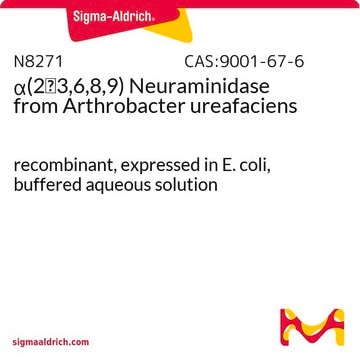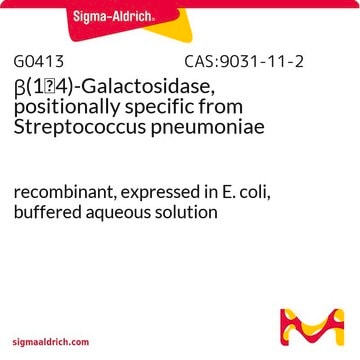N7271
α(2→3) Neuraminidase from Streptococcus pneumoniae
buffered aqueous solution
Synonym(s):
Acyl-neuraminyl Hydrolase, Acylneuraminyl hydrolase, Receptor-destroying enzyme, Sialidase
About This Item
Recommended Products
biological source
Streptococcus pneumoniae
Quality Level
form
buffered aqueous solution
concentration
≥5 units/mL
foreign activity
β-Galactosidase, α-mannosidase, β-hexosaminidase, α-fucosidase, and proteases, none detected
shipped in
wet ice
storage temp.
2-8°C
Gene Information
Streptococcus pneumoniae R6 ... nanB(933504)
Related Categories
Biochem/physiol Actions
Packaging
Unit Definition
Physical form
Preparation Note
Signal Word
Danger
Hazard Statements
Precautionary Statements
Hazard Classifications
Resp. Sens. 1
Storage Class Code
13 - Non Combustible Solids
WGK
WGK 1
Flash Point(F)
Not applicable
Flash Point(C)
Not applicable
Personal Protective Equipment
Certificates of Analysis (COA)
Search for Certificates of Analysis (COA) by entering the products Lot/Batch Number. Lot and Batch Numbers can be found on a product’s label following the words ‘Lot’ or ‘Batch’.
Already Own This Product?
Find documentation for the products that you have recently purchased in the Document Library.
Customers Also Viewed
Articles
Understand sialic acid structure, function, signaling, and modifications. Easily find products for sialic acid research.
Our team of scientists has experience in all areas of research including Life Science, Material Science, Chemical Synthesis, Chromatography, Analytical and many others.
Contact Technical Service






